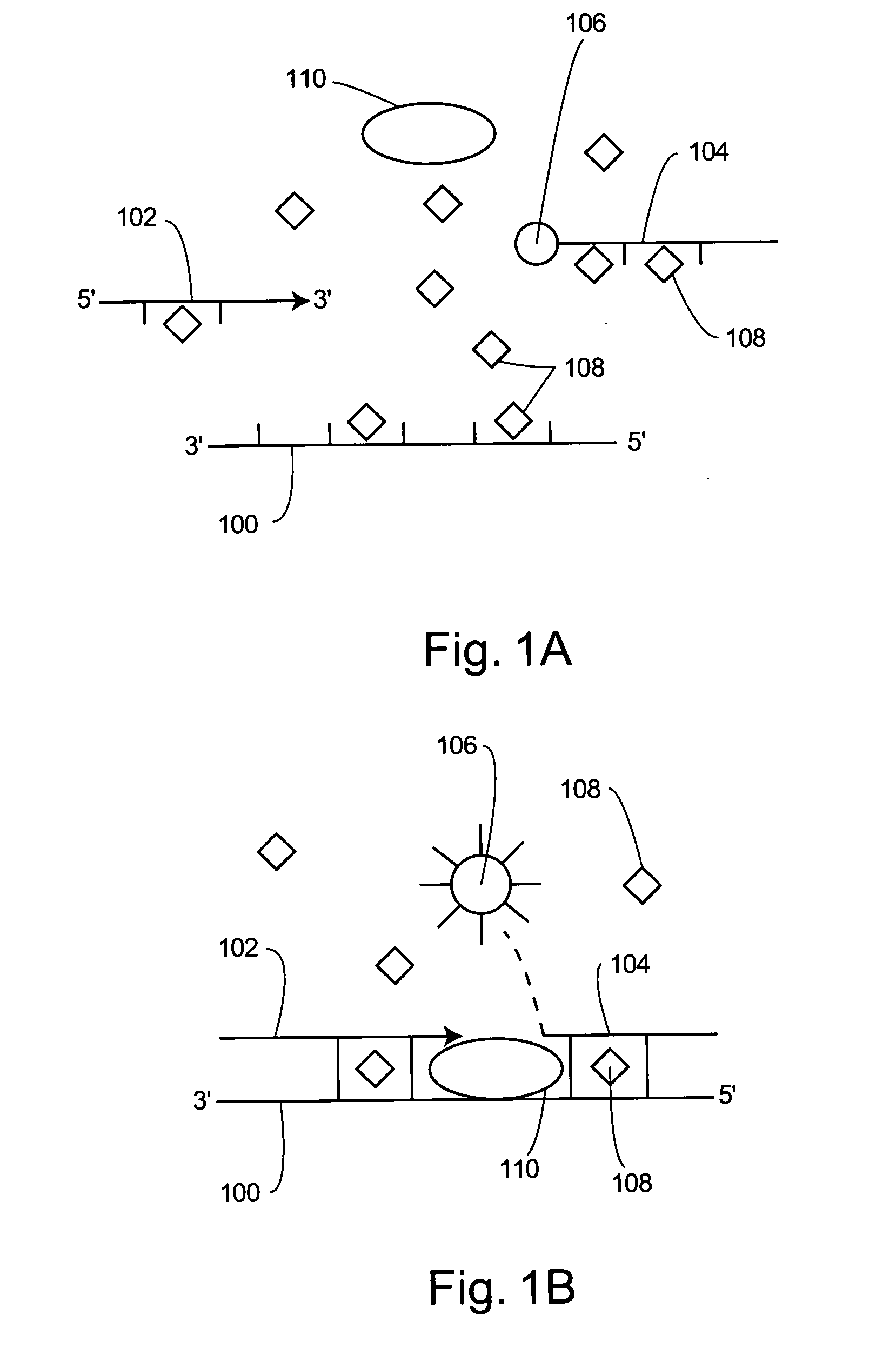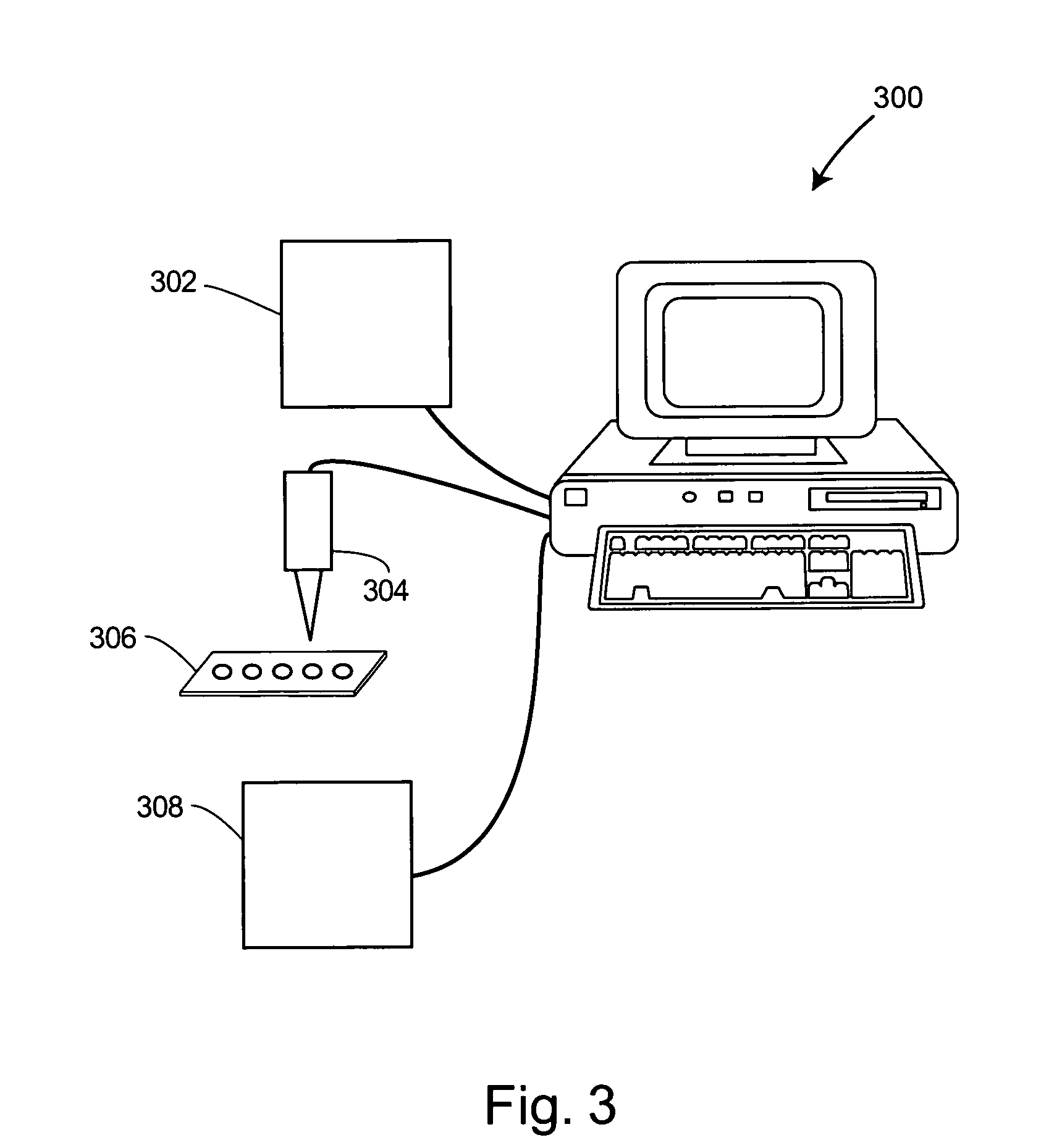Light emission modifiers and their uses in nucleic acid detection, amplification and analysis
a technology of light emission modifier and nucleic acid, applied in the field of molecular biology and nucleic acid chemistry, can solve the problems of complex quality control process, high cost, and difficulty in detecting nucleic acid, and achieve the effect of improving the detection accuracy and accuracy of the detection results
- Summary
- Abstract
- Description
- Claims
- Application Information
AI Technical Summary
Benefits of technology
Problems solved by technology
Method used
Image
Examples
example 1
General Protocols for Fluorescence Quenching Assays
[0276] The tables included in this section describe the respective reaction components, conditions, and procedures that were utilized in the analyses referred to in the examples provided below, unless specified otherwise. In general, the fluorescence of labeled oligonucleotides was measured in solutions both with and without a soluble quencher. In certain analyses, for example, a series of probes labeled with FAM at the 5′ end were measured in 400 μL solutions containing a PCR reaction buffer (described below) and various concentrations of soluble quenchers. For detecting the fluorescence of the FAM label in those analyses, the wavelength of the excitation light was chosen to be 485 nanometers and the fluorescence was measured at a wavelength of 520 nanometers.
[0277] General Methods used for PCR Evaluations
TABLE IIIReaction mixture for quenching analyses using a single strandedfluorescent oligonucleotide:ComponentConcentrationpo...
example 2
Single-Labeled Probes
[0292] This Example and Examples that follow illustrate various performance characteristics of assays that included the use of light emission modifiers described herein and assorted single-labeled probes. This example illustrates the quenching of fluorescence with various light emission modifiers of the invention.
[0293]FIG. 4 is a graph (ordinate represents percent fluorescence, abscissa represents concentration (μg / mL)) that shows the quenching of fluorescence from different single-labeled nucleic acids with various concentrations of new methylene blue. As shown in the legend that accompanies the graph, the plots are for a single-labeled, single-stranded oligonucleotide having a sequence of 31 nucleotides (i.e., a 31-mer (GAG108AF; ETCTGCAGCTTCCTCATTGATGGTATCTTTTAP, where E=FAM and P=phosphate (SEQ ID NO: 13))), a single-labeled, double-stranded 31-mer, and a single-labeled dinucleotide or dimer at the indicated new methylene blue conce...
example 3
Polymerase Chain Reactions using Single Label Probes and Azure Dyes
[0298] This example illustrates the embodiment describing real time detection with a single-labeled probe and a light emission modifier of the invention.
[0299]FIG. 9 is an amplification plot (ordinate represents absolute fluorescence, abscissa represents the cycle number) that shows data obtained from various 5′-nuclease reactions that included single-labeled 5′-nuclease probes and various concentrations of azure B in HCV detection assays. The single-labeled ST650 probes (corresponding to SEQ ID NO: 5) used in the reaction mixtures represented by these traces were labeled at 5′-ends with FAM. The reaction mixtures also included poly rA. The labels accompanying the traces show the concentration of azure B used in each of these reaction mixtures. The relative fluorescence as a function of light emission modifier concentration for these reactions is plotted in FIG. 11. This plot shows, e.g., that relative fluorescence...
PUM
| Property | Measurement | Unit |
|---|---|---|
| temperature | aaaaa | aaaaa |
| temperature | aaaaa | aaaaa |
| temperature | aaaaa | aaaaa |
Abstract
Description
Claims
Application Information
 Login to View More
Login to View More - R&D
- Intellectual Property
- Life Sciences
- Materials
- Tech Scout
- Unparalleled Data Quality
- Higher Quality Content
- 60% Fewer Hallucinations
Browse by: Latest US Patents, China's latest patents, Technical Efficacy Thesaurus, Application Domain, Technology Topic, Popular Technical Reports.
© 2025 PatSnap. All rights reserved.Legal|Privacy policy|Modern Slavery Act Transparency Statement|Sitemap|About US| Contact US: help@patsnap.com



